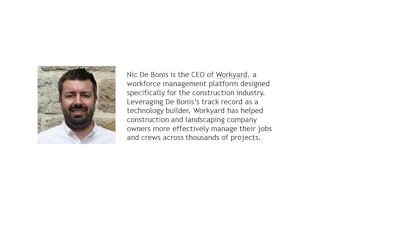
How employees respond to problems, how engaged they are in their work, and how honest they are with reporting hours — it’s tempting to think that these things are just a function of a person’s character. But the reality is that they’re heavily influenced by company culture.
In a nutshell, that’s why culture is just as important for a localized landscaping crew as it is for a technology company or a multinational brand.
That being the case, leaders in the green services sector can benefit from asking two questions about their businesses: What are the advantages of a healthy culture? And, how does our organization build one?
But before diving into those, let’s look quickly at what “culture” even means.
What is company culture?
Culture is about both actions and attitudes. How does the organization act, and how does it encourage its employees to act? What gets held up high as the golden standard of how to behave, and what gets swept under the rug, or simply tolerated? In practical terms, the culture of your organization simply refers to what it’s like to work there, and this absolutely does matter to your team members.
Studies and surveys have repeatedly shown that for a majority of the workforce (and especially for younger employees and job-seekers) culture matters more than compensation. Also, according to research by Glassdoor, 73% of adults in the U.S. won’t even apply to a company whose values don’t align with their own. The bottom line is that employees care deeply about workplace culture, whether or not they think of it or call it by that name.
What is the advantage of a healthy culture?
There’s a long list of positive outcomes associated with having a healthy business culture, and countless think tank studies to back them up with hard data. But when you get down to it, it’s just common sense.
In fact, it’s a lot like sports. You can have the best players, the best coaches, and the best strategy, but if you don’t have an organization that’s on the same page from top to bottom, you can feel the negative effects on the bench or in the dugout. The team has to believe in itself, and in order to do that, it has to trust its leadership.
When you’ve got that going on, things just seem to fall into place.
For the most part, when there's strong culture, everybody trusts each other and helps each other. They’re excited to show up, willing to work hard, and proud of their contribution. They want to be there, and it shows. That makes it easier to keep them there and to attract new talent, too. With landscaping specifically, this is more important than ever. Industry-wide growth has made it tough to get and retain skilled people, and few companies can afford to jack up salaries to compensate. Leveraging the intangibles – like a healthy, positive culture – is one of the moves they can make.
Culture matters to clients and business partners, too. Given a choice, almost everyone would prefer to work with a company that demonstrates quality values like honesty, transparency, and basic human decency. If you have to think twice about whether your company meets that standard, you’ve probably got some culture-building to do.
How do you create a healthy culture?
It’s easy to get lost in the weeds (no pun intended) trying to figure out whether or not your company’s culture is up to par or what you can do in order to boost its value. You could read dozens of books on the subject. Or you could focus on these simple strategies.
1. Start with communication
Employees want to speak and want to feel heard. Many want to contribute with ideas, not just raw labor, and they all want recognition for a job well done. They also want to be connected with their colleagues, but only one in four feel like that’s the case. The common denominator in all of these things is communication.
Obviously, communication can be a challenge in landscaping, with team members potentially distributed across many locations at a given time, but technology is more than capable of bridging the gap. Scheduling regular employee satisfaction interviews and facilitating company-wide conversations using a simple messaging app are two easy steps you can take toward building a communicative culture that will pay dividends.
2. Increase transparency
The benefit of transparency is a higher level of trust, and while it goes hand in hand with communication, it doesn’t come automatically. In most companies, it needs to be actively cultivated and explicitly encouraged before it will become the norm. One way owners can do this is by infusing transparency directly into day-to-day operations with apps that track costs, work hours, and other data in real-time.
3. Develop your employees
For every three employees that quit, one does it because they want a new challenge. Not mad, not underpaid, not unable to work – just bored. Other relevant statistics include the fact that 90% of millennials and 80% of all employees say that they’d rather get a new perk or benefit from their employer than a pay raise.
The point is that people want room to grow, and part of the fulfillment they’re looking for in the workplace is the chance to learn new things or practice different skills. Even if you can’t give them a promotion or afford to pass out tuition reimbursement, you can almost certainly find ways to provide opportunities for employees to learn and move laterally within the organization. The more you do, the more engaged they’ll be and the longer they’ll stick around – additional elements of a healthy culture.
The bottom line?
A great workplace culture can have unique qualities and be founded on any number of different strategies. What all companies with strong, positive cultures have in common is that they care about what employees want and offer a work environment that motivates people to want to be productive. In the past, landscapers could scrape by without caring too much about those factors. Now, with the labor pool thinning and demand skyrocketing, owners need to do everything they can to create a competitive advantage for their businesses, and that starts by looking inside.
Editor's Note: This guest post was written by Nic De Bonis, the CEO of Workyard.










